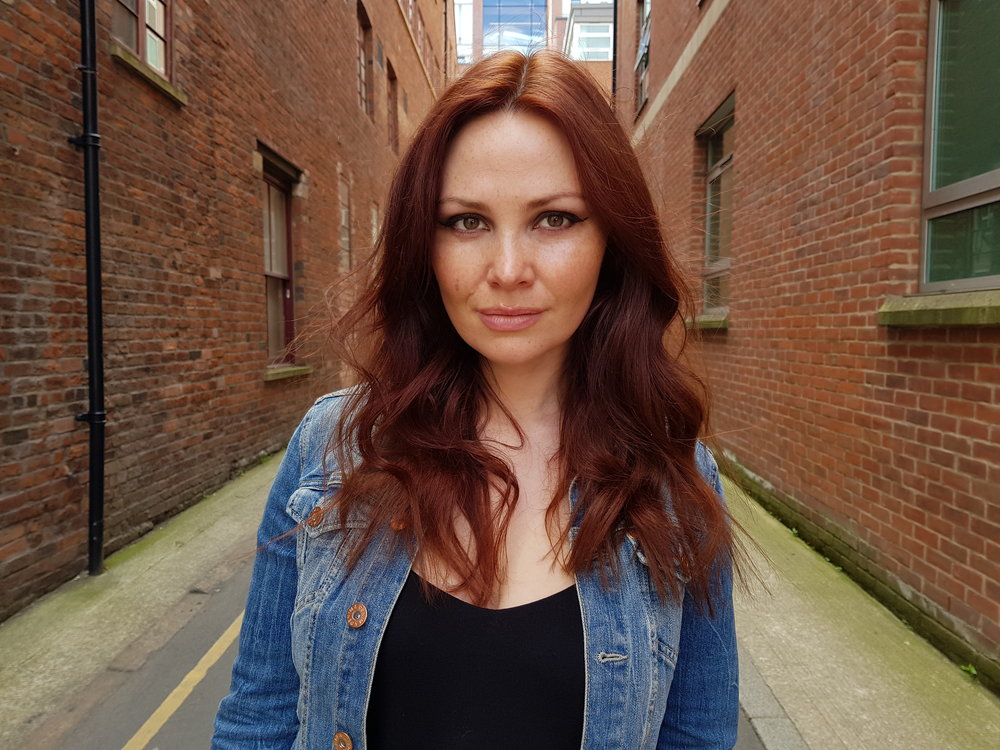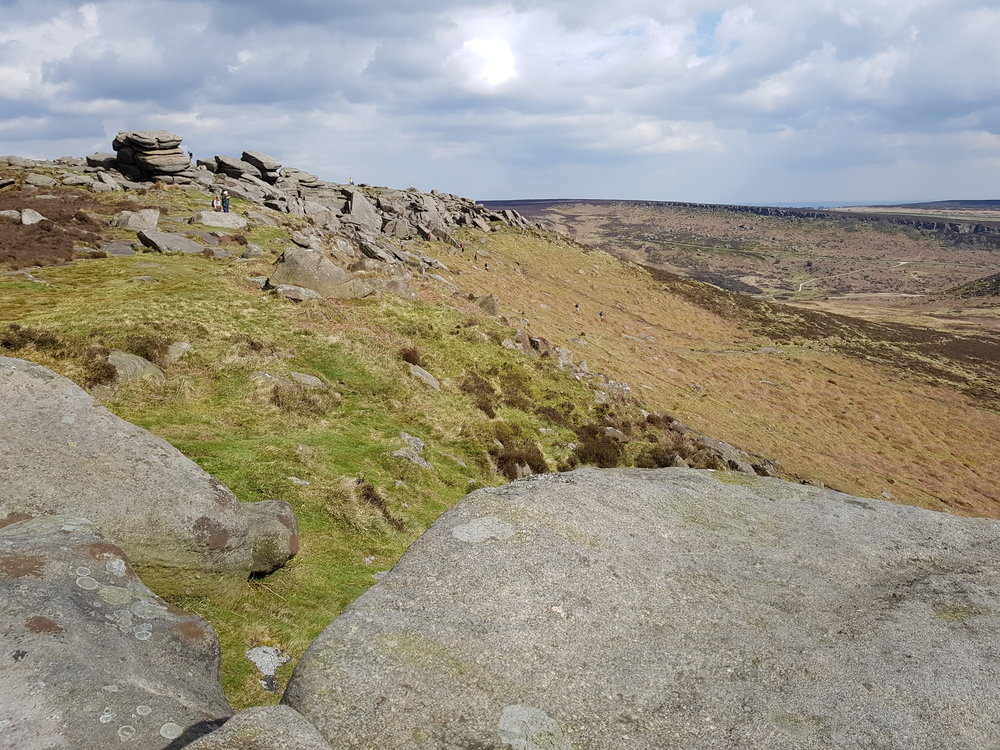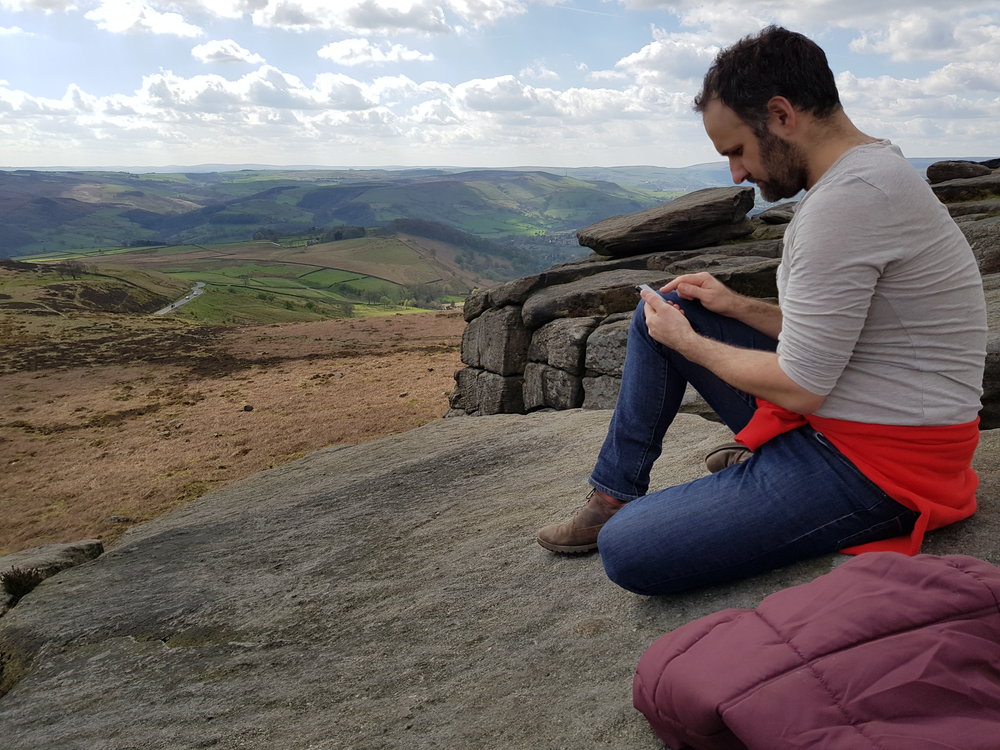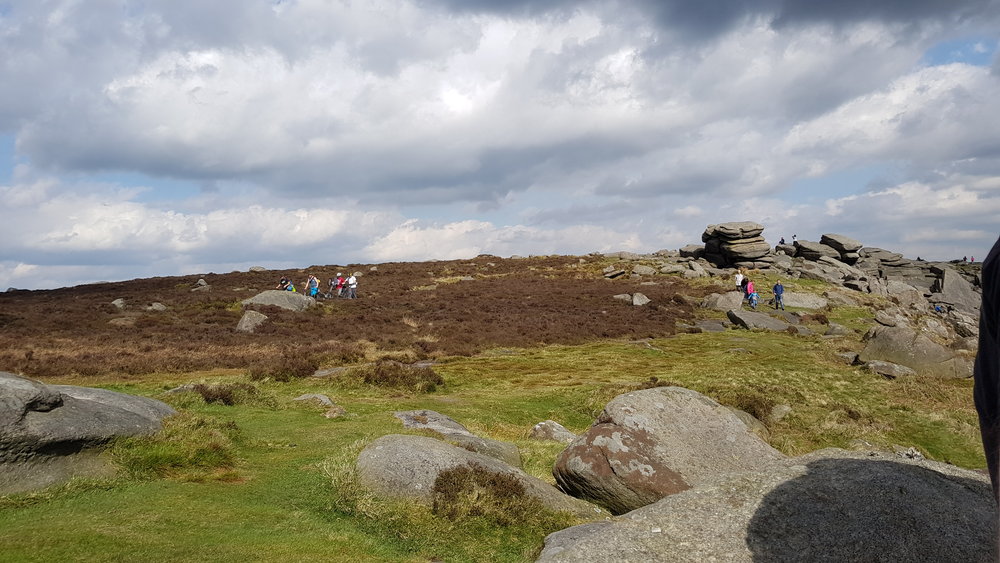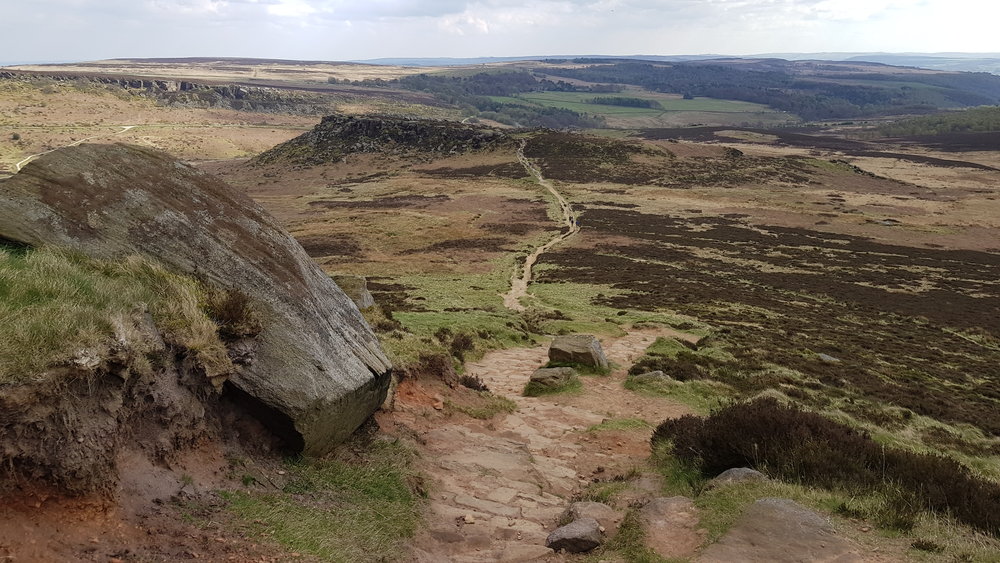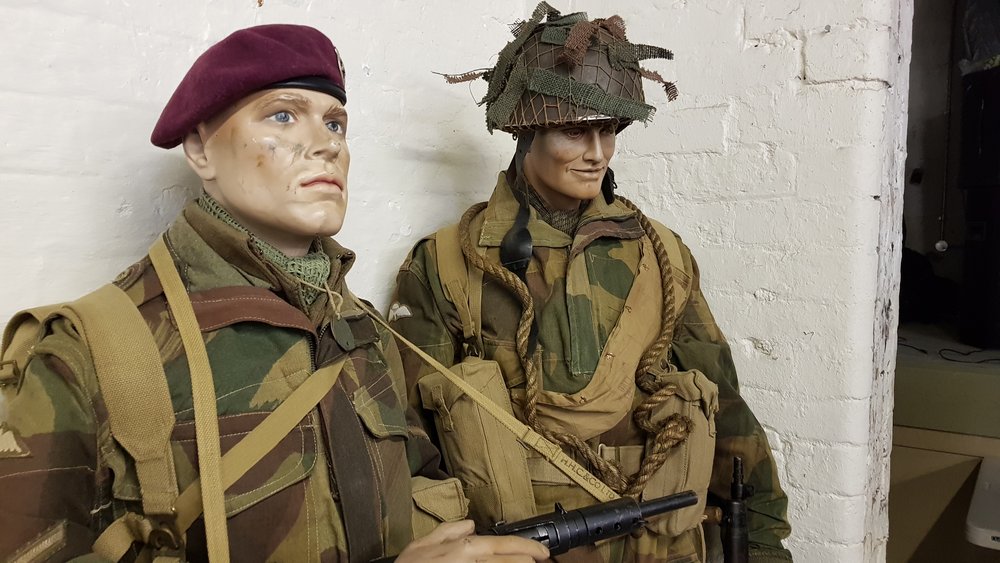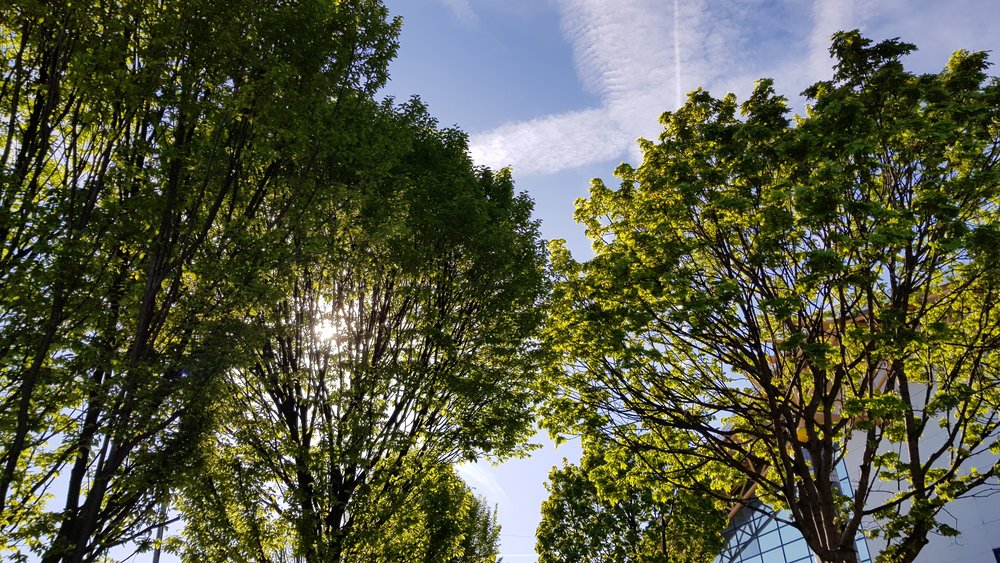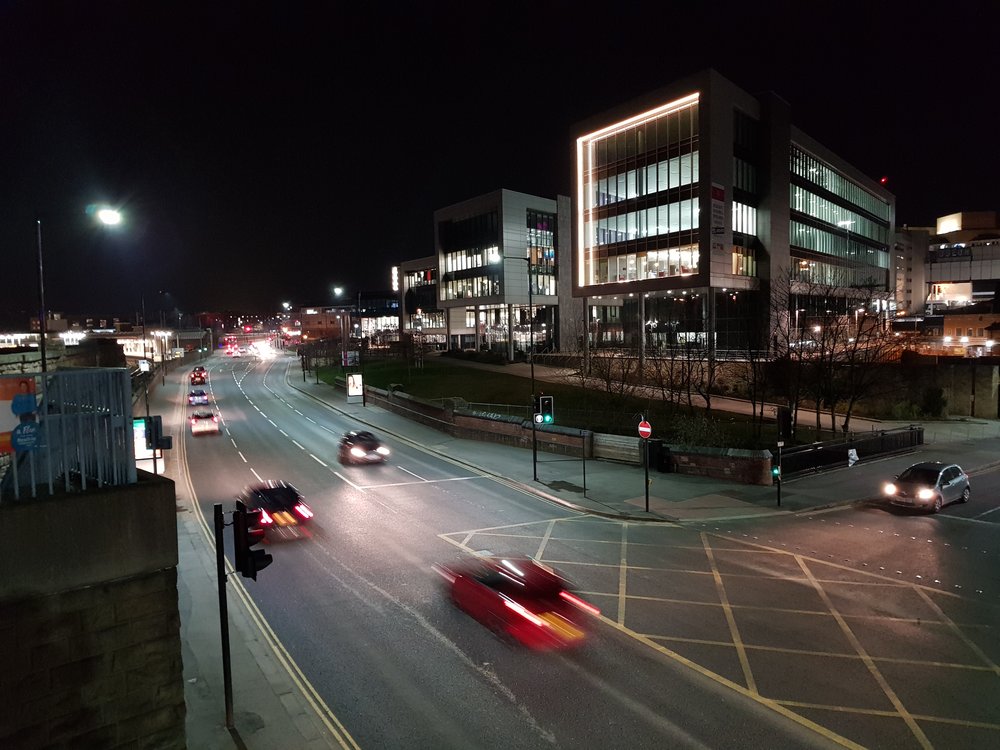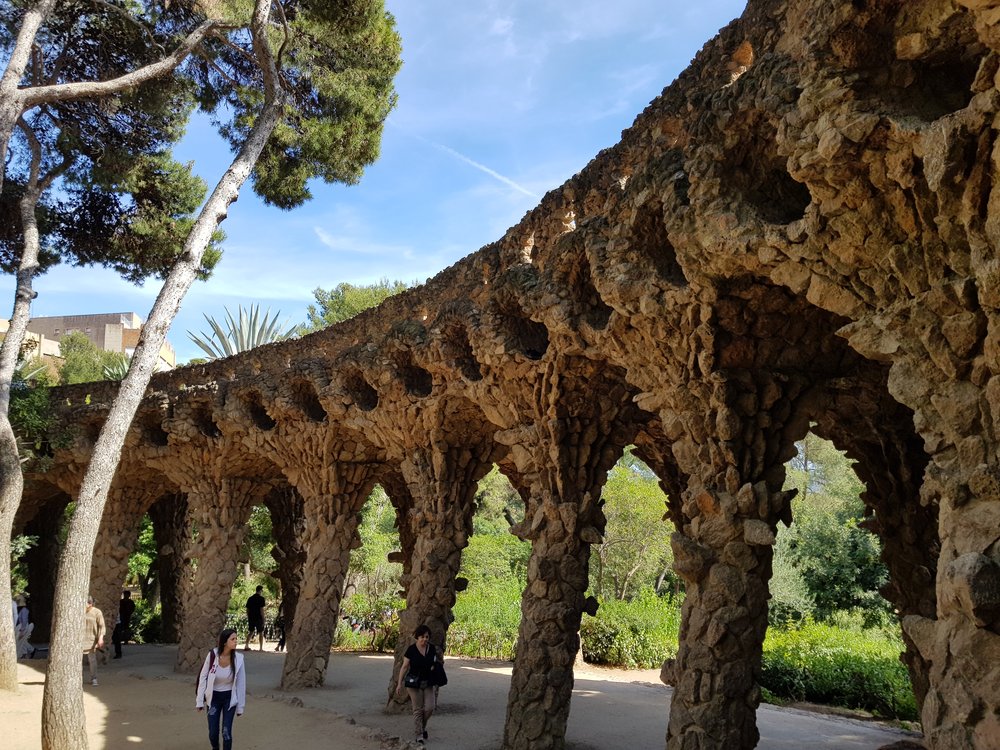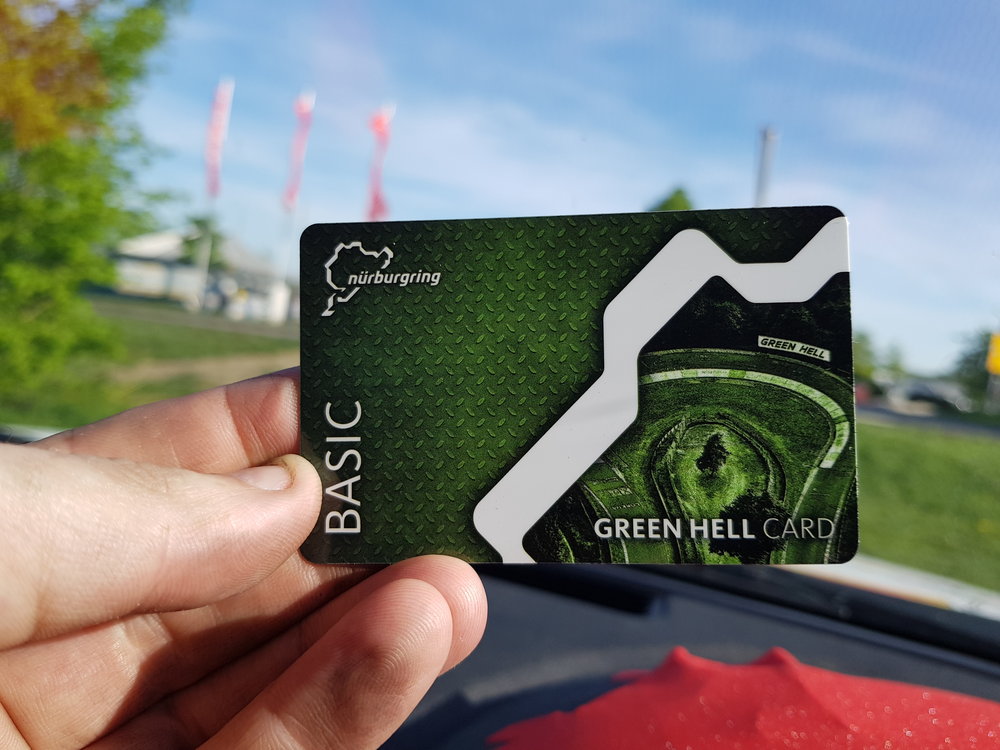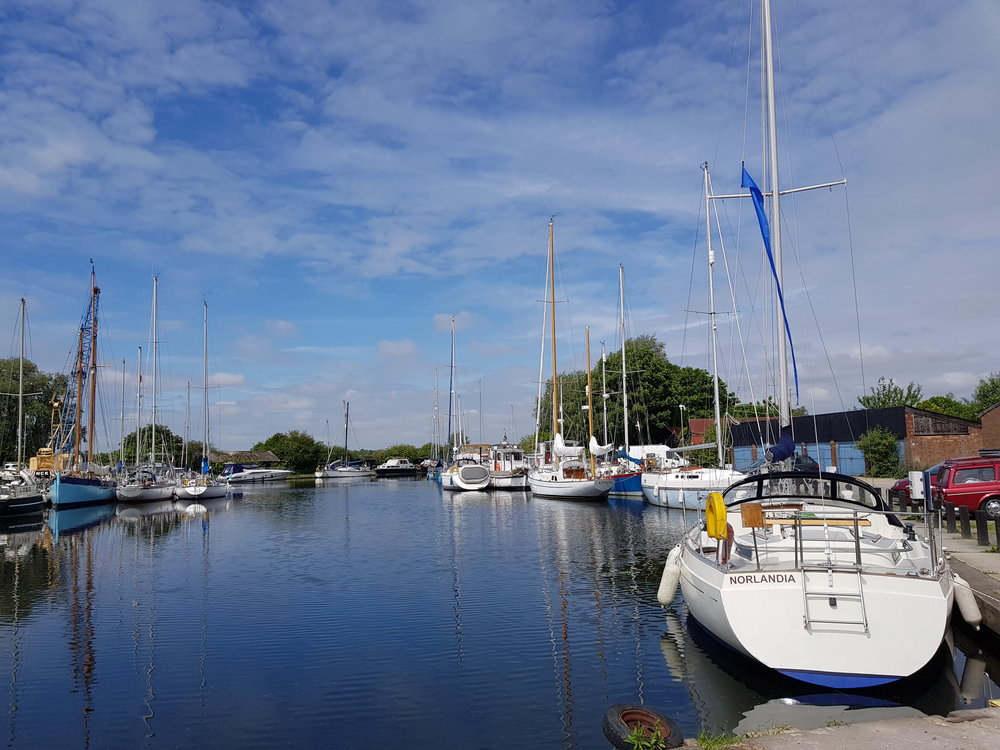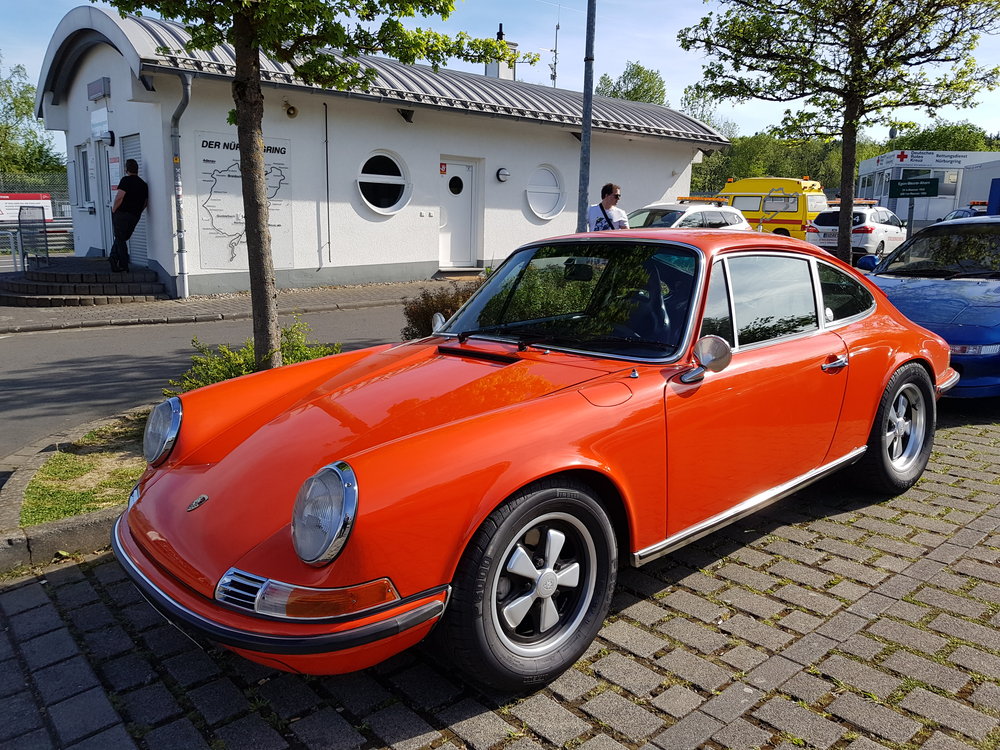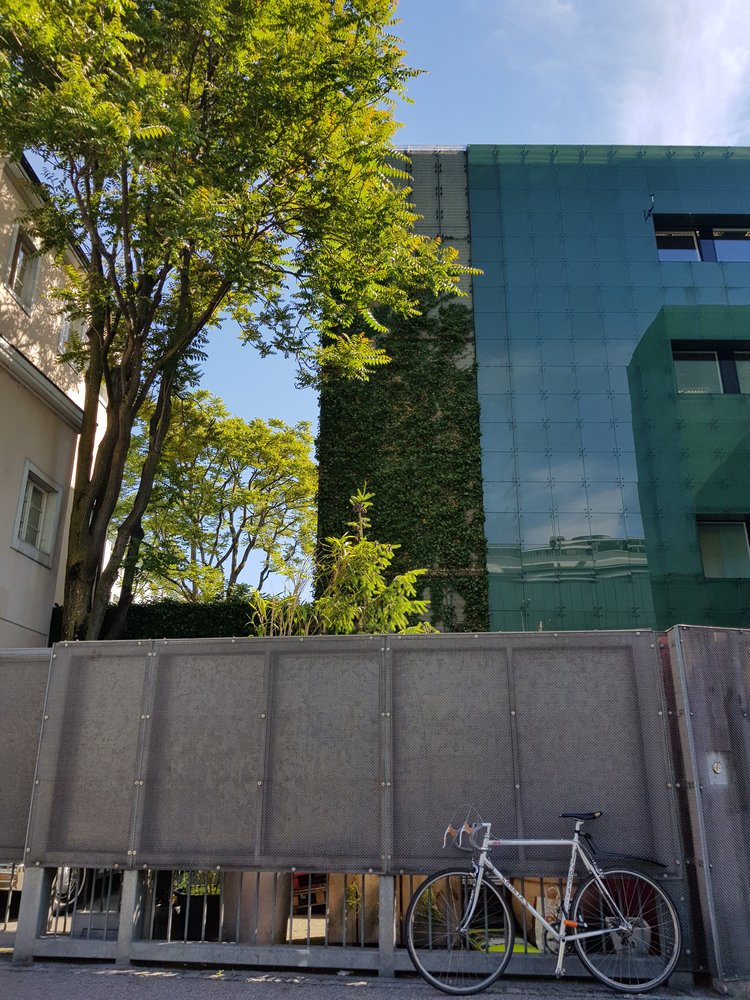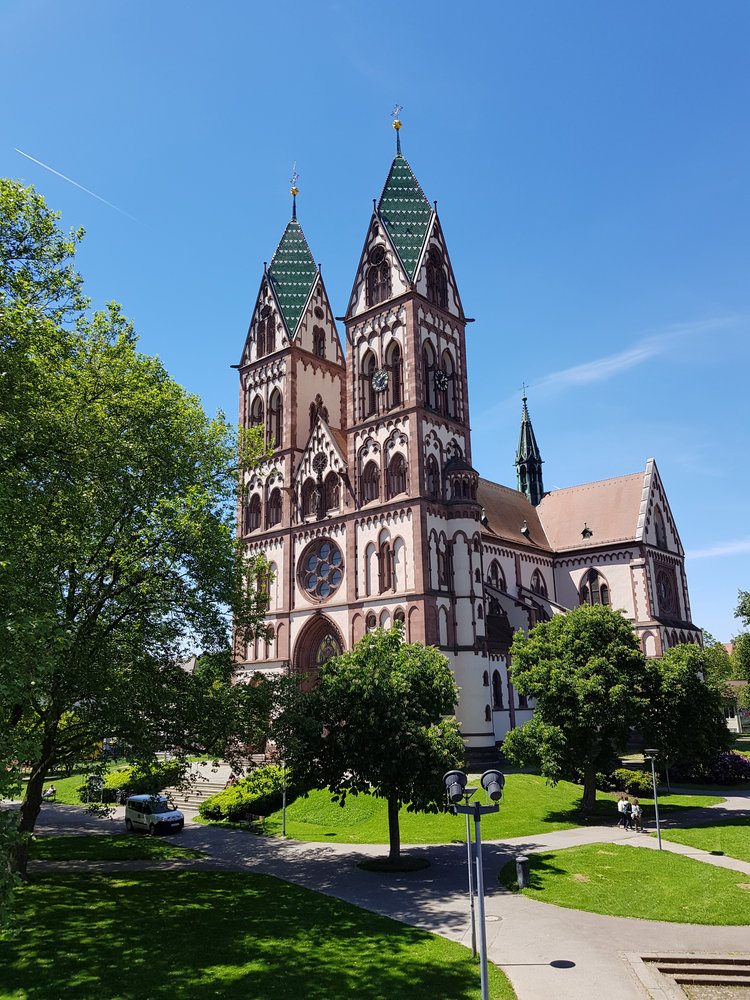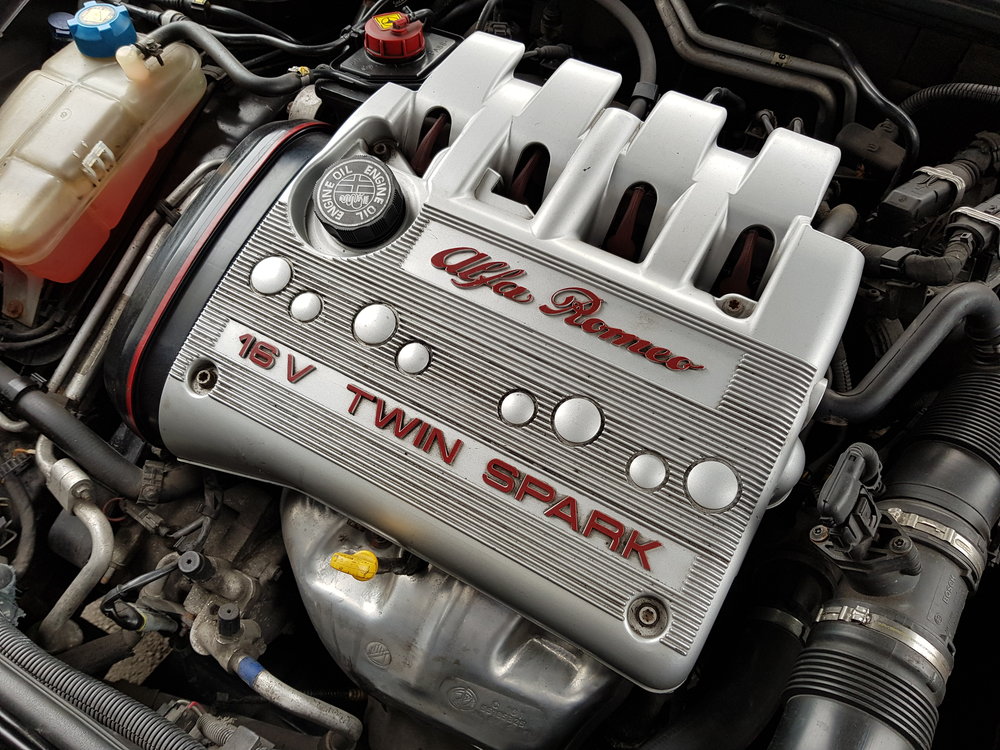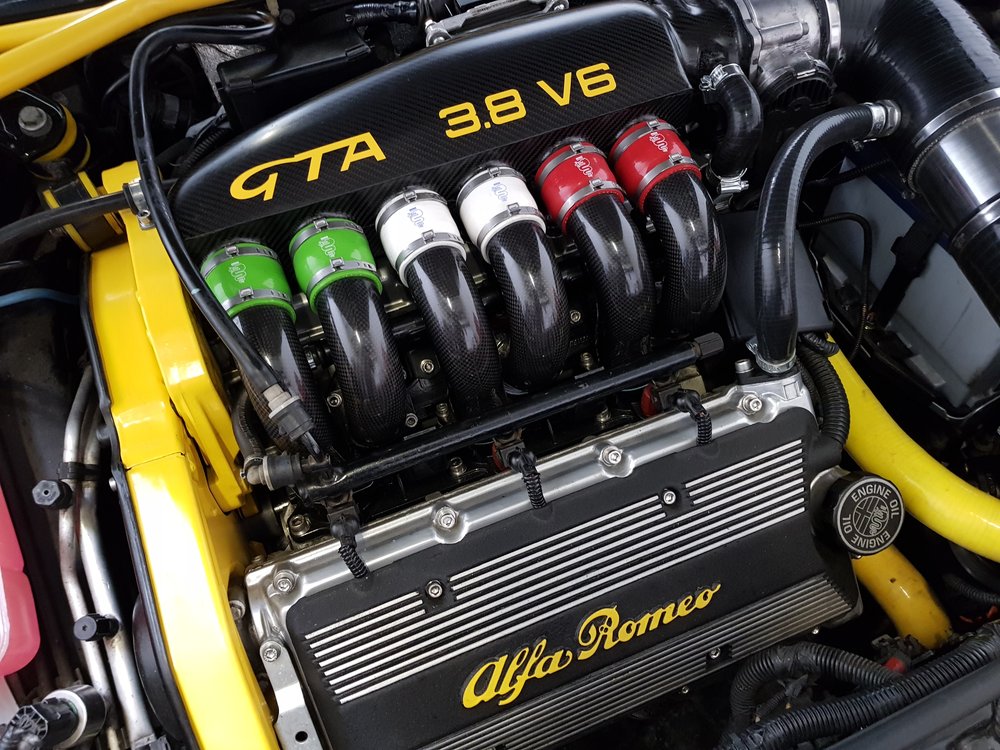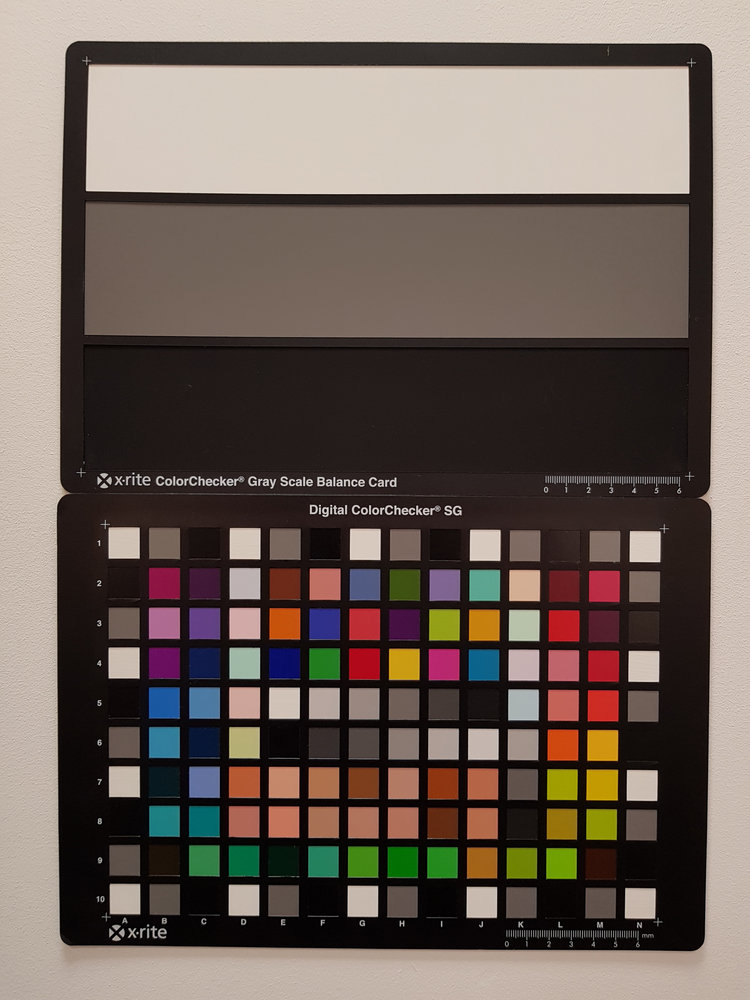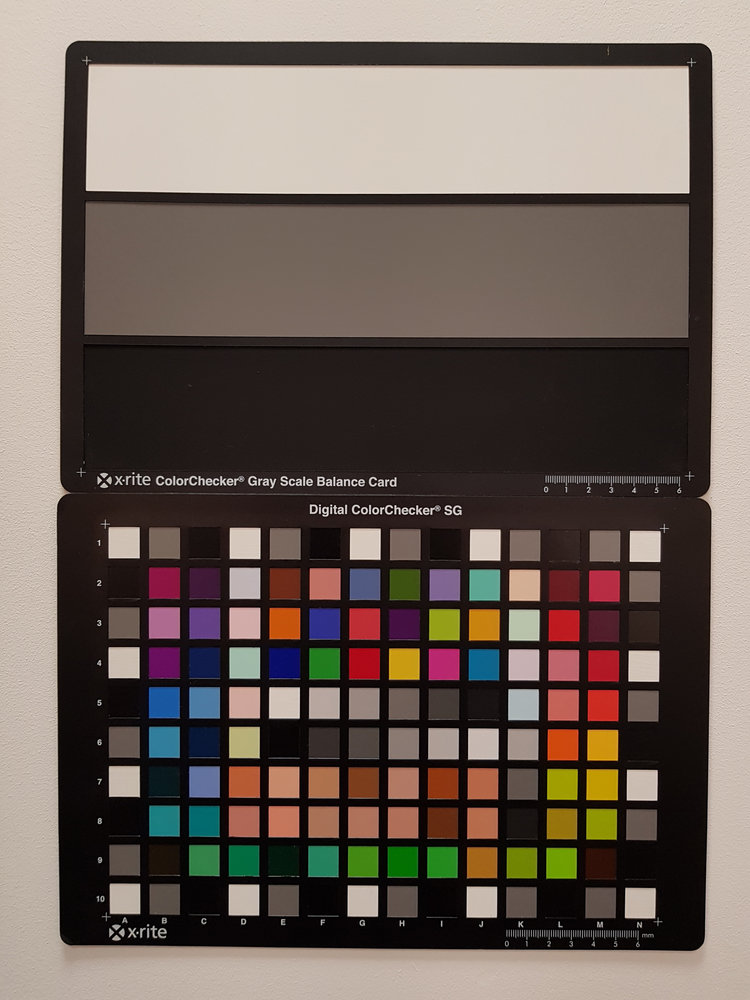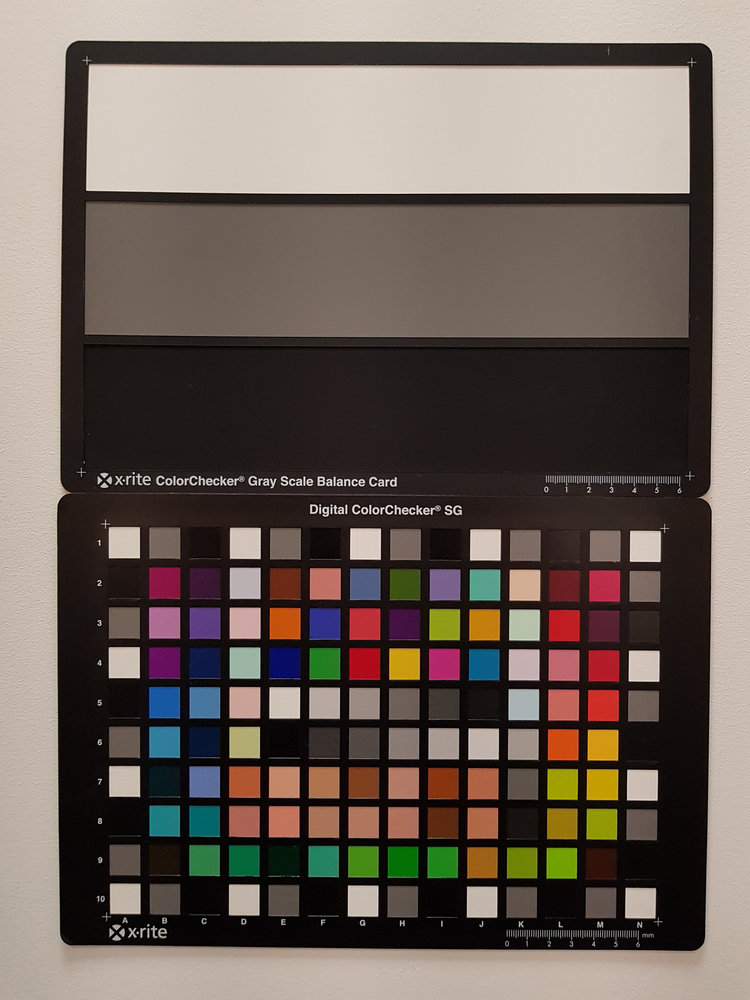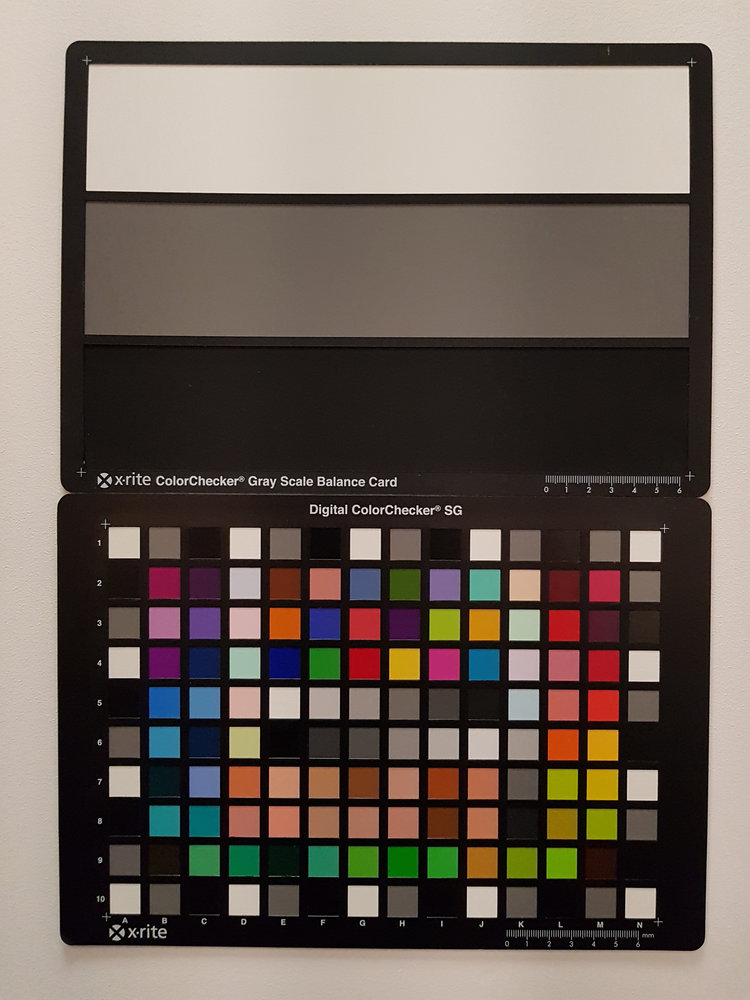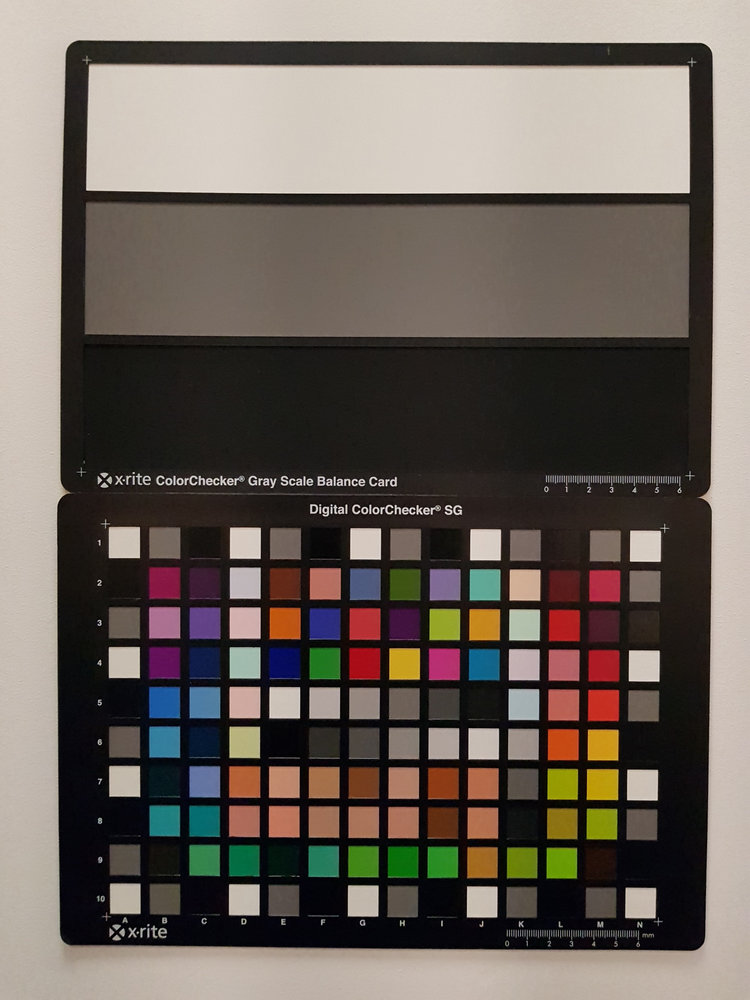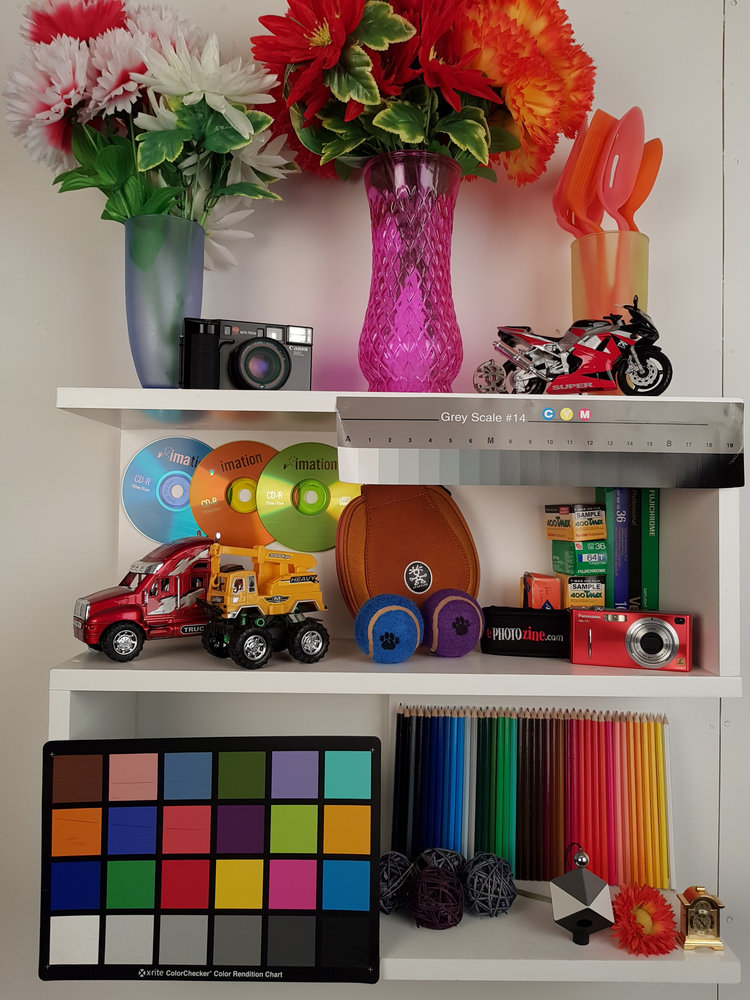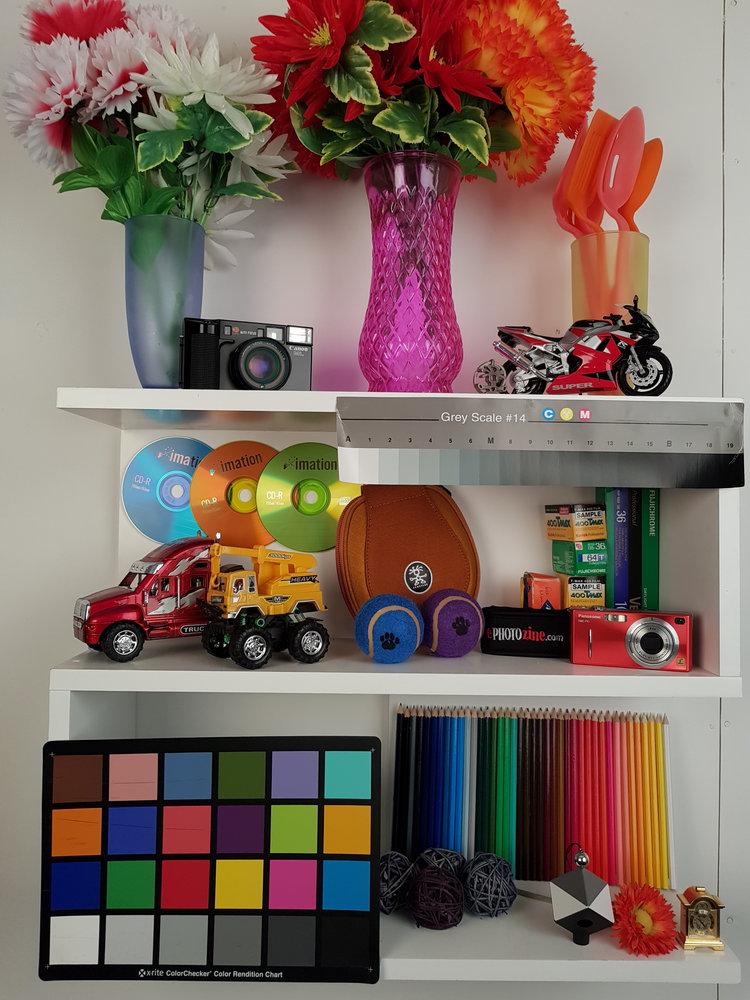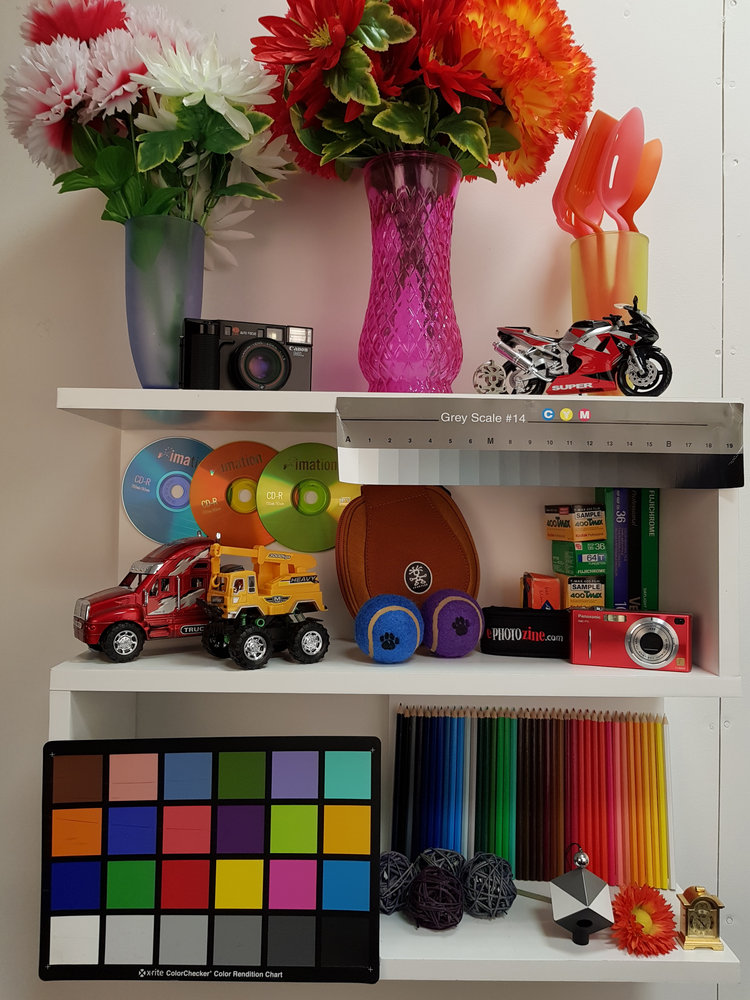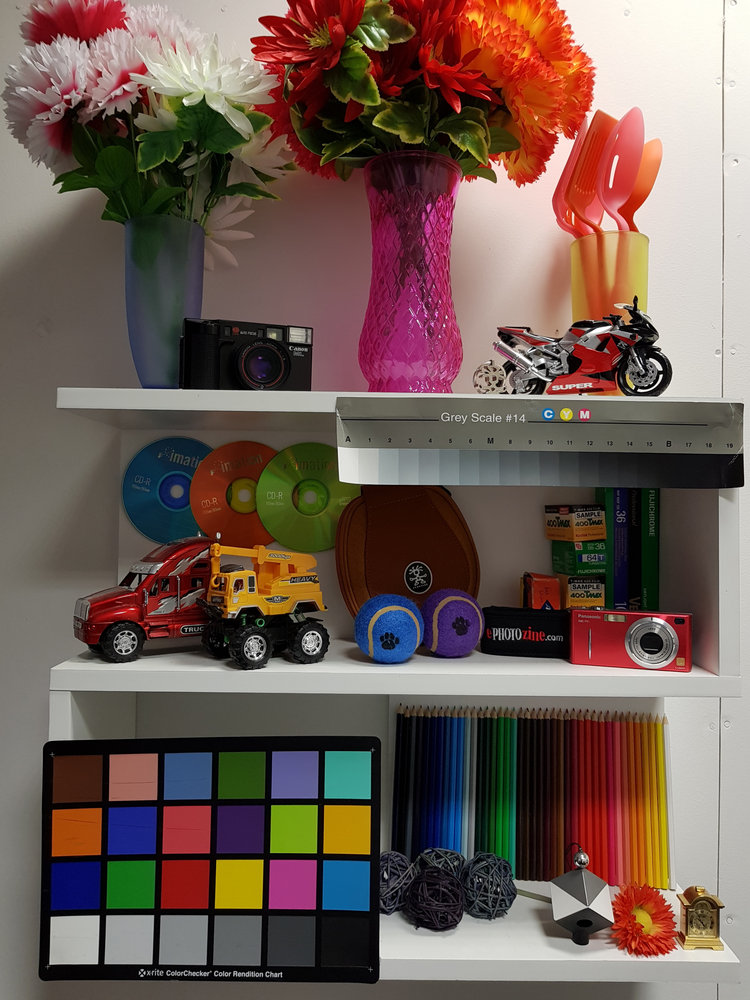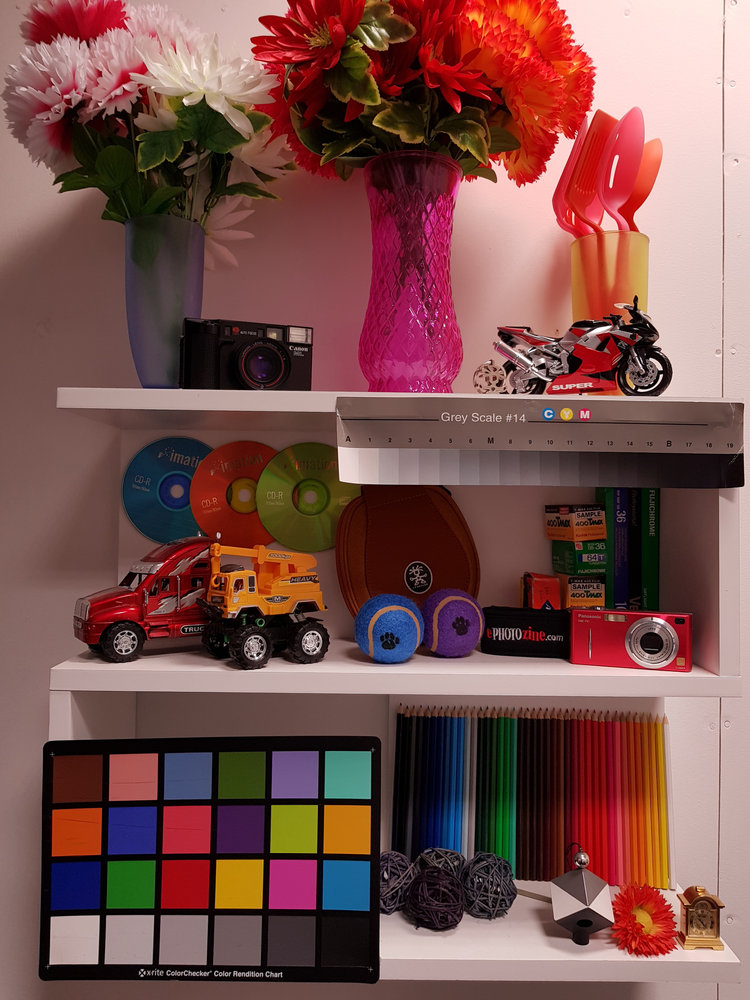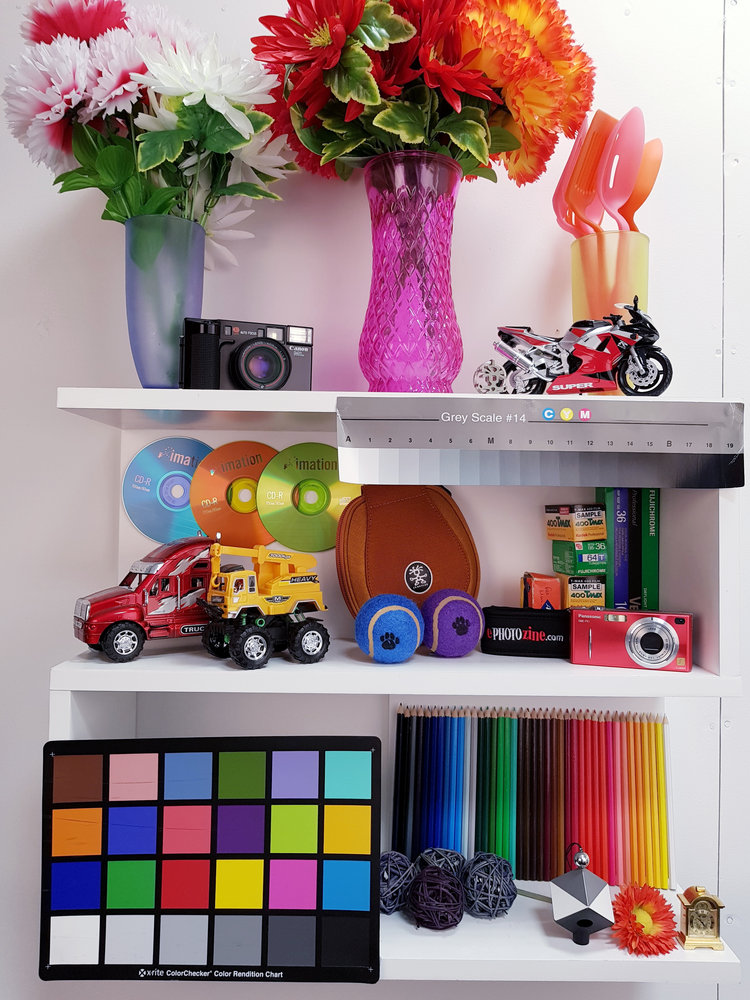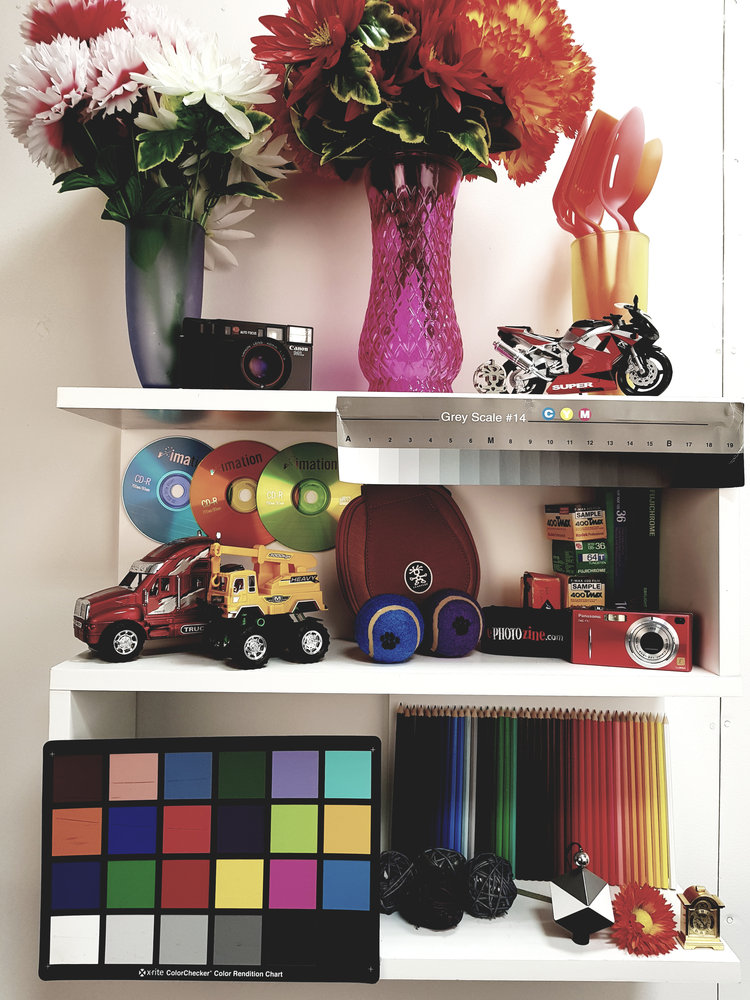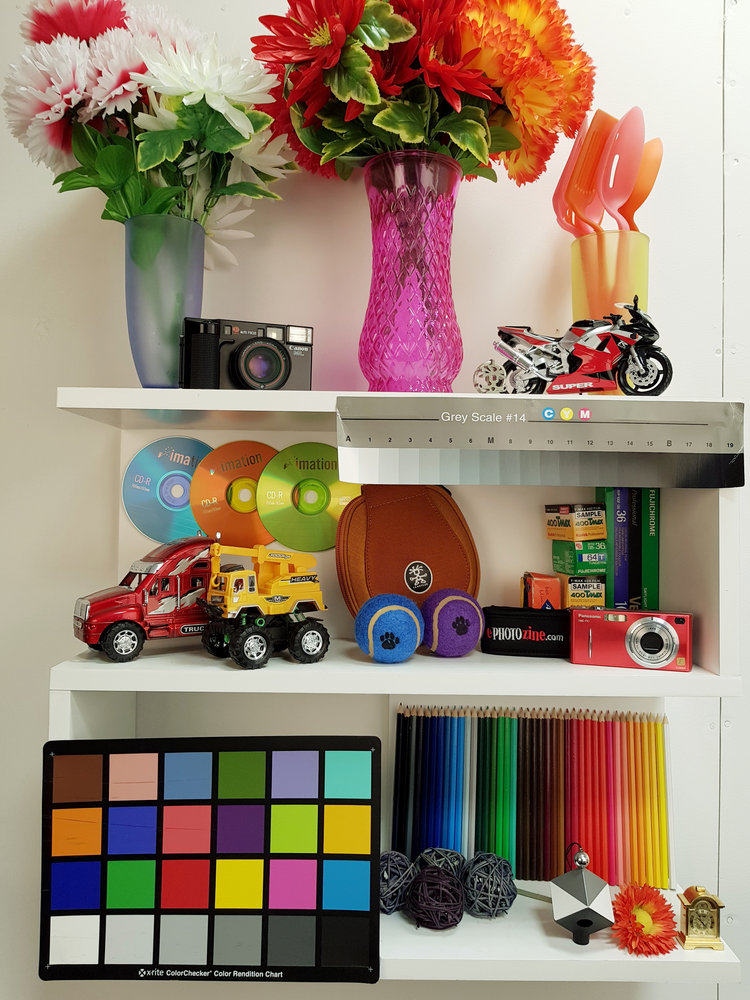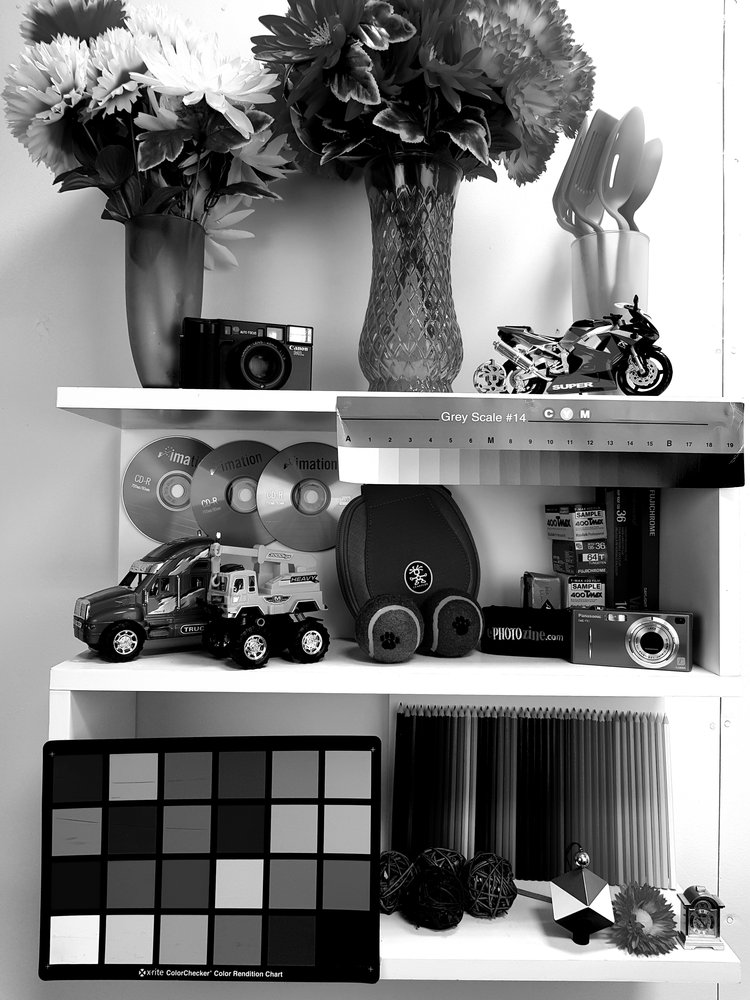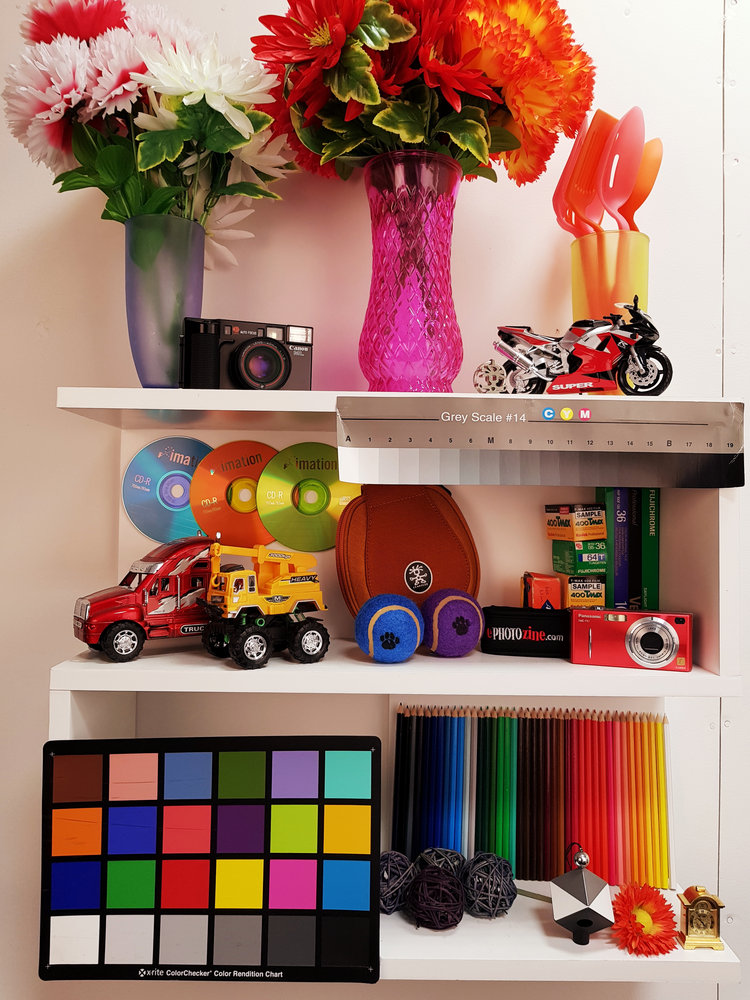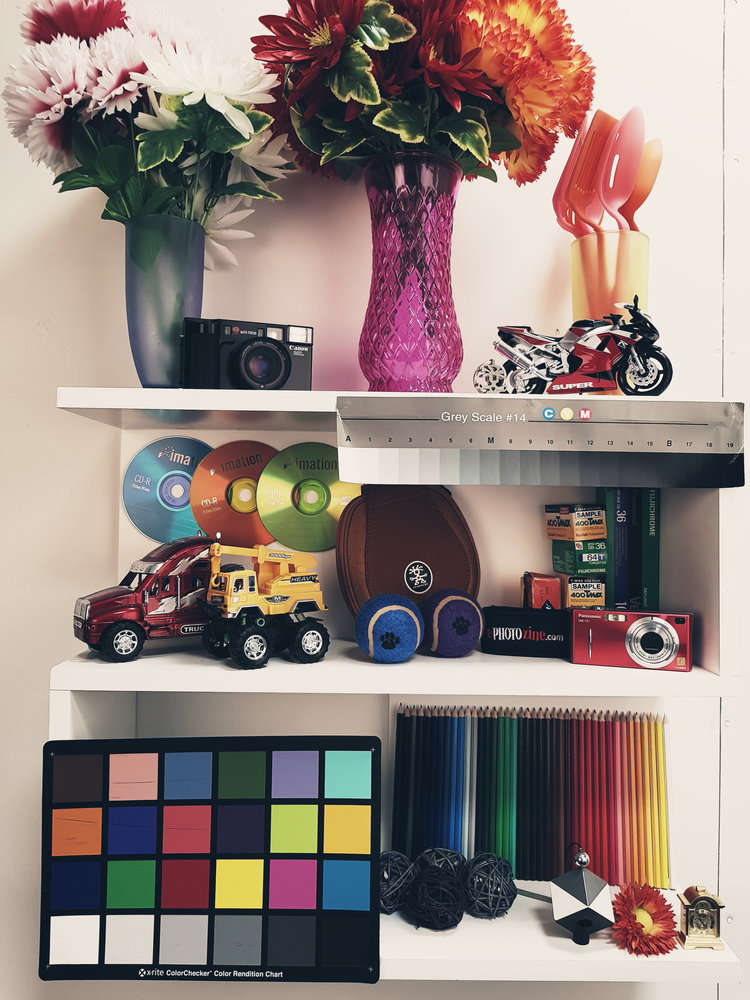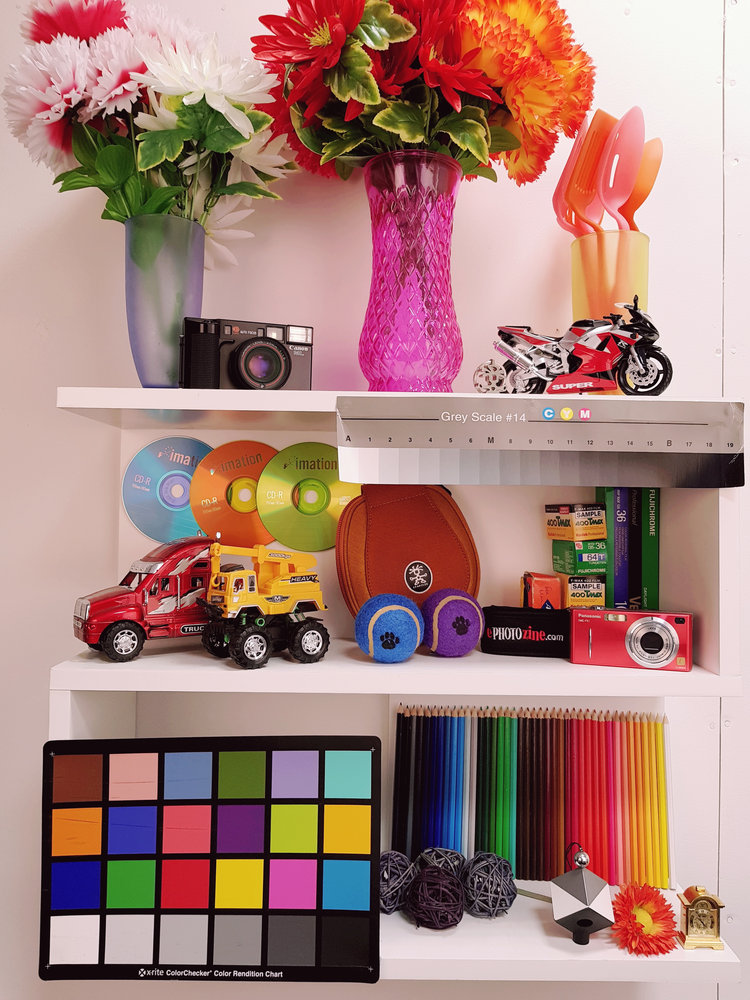
The Samsung Galaxy S8 and S8+ are Samsung's flagship mobile phones, announced in March 2017. They both feature a new curved edge "Infinity Display" which is designed to give maximum screen size, whilst maintaining a small phone size, with a 5.8inch screen on the S8 and a 6.2inch on the S8+. Both smartphones feature a 12 megapixel rear camera with an f/1.7 aperture, and optical image stabilisation (OIS). The front camera has been updated to an 8 megapixel camera, with a bright f/1.7 aperture. A second front camera has been added for face recognition which can be used to unlock the phone.
Samsung Galaxy S8 Features
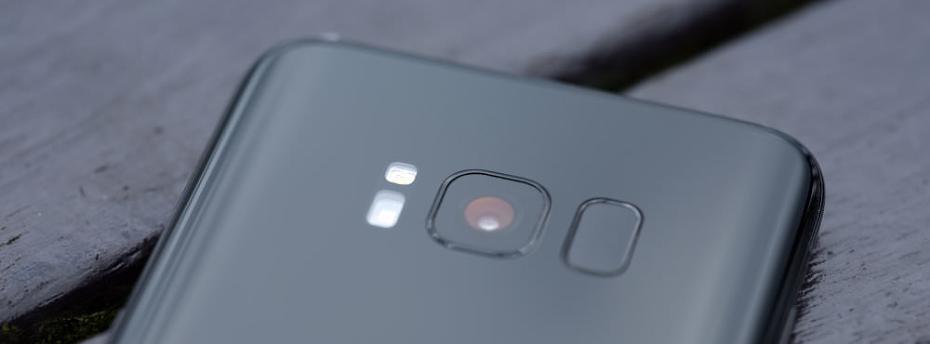
The Samsung Galaxy S8 camera remains very similar to the excellent camera found in the Samsung Galaxy S7, with a 12-megapixel dual pixel sensor, and a f/1.7 aperture on both the front and rear cameras. There have been updates made to the software, with the camera app now featuring "Bixby Vision" built-in - letting you search the internet for similar items to what you've taken a photo of.
The Galaxy S8 has the latest SnapDragon 835 processor, 4GB of RAM and 64GB of storage. There is the capability to insert a microSD card into the phone, allowing for much greater storage when you're taking lots of pictures, although most people probably won't need it.
The S8 is also dust resistant and water resistant, with Samsung claiming it can withstand a half - hour dunking up to 1.5m down. It's also got protection if you drop it - Corning Gorilla Glass 5 is used on both the screen and the back panel, making it tough.
The 12 megapixel back camera has 1.4um pixels, which are quite large for a smartphone, and allow the sensor to gather more light, and the camera also has optical image stabilisation. Touch focus can be used and 4K video can be recorded whilst simultaneously capturing 9-megapixel images. It's said to have incredibly fast autofocus, thanks to every pixel on the dual pixel sensor being used for phase detection. This means that the autofocus of the phone is blisteringly fast, capturing sudden movements.
There is a built-in LED flash on the rear, and the front screen can be used as a selfie flash when using the front camera, in low-light conditions.
Shooting modes include Auto, pro, panorama, selective focus, slow-motion, hyper lapse, food and virtual shot.
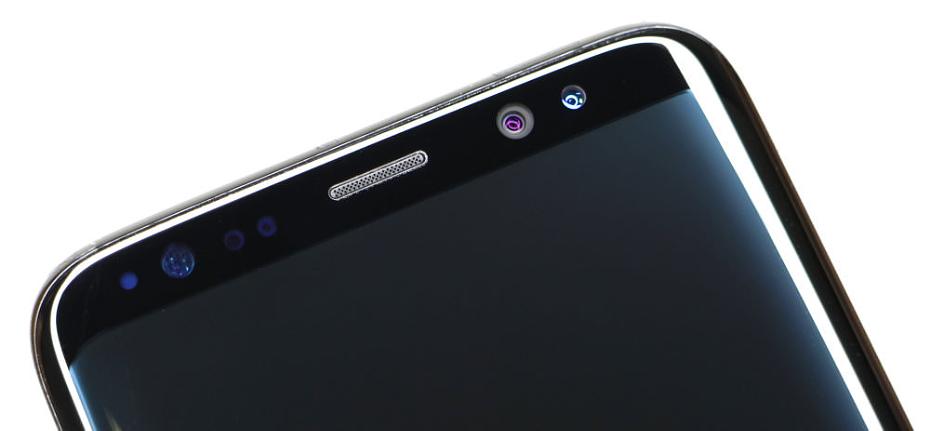
The front "selfie" camera has been updated to an 8-megapixel camera, with a bright f/1.7 aperture, and auto-focus. Next to this, you can see an additional front camera, which is used for face recognition which can be used to unlock the phone. You can also use Iris recognition to unlock the phone or the fingerprint sensor on the back. There are additional sensors on the front as well (on the left). The front camera features Auto HDR and can record video up to QHD resolution (2560x1440), and FullHD with HDR.
As with all smart devices these days, it's simple to share your images via Wi-Fi or on social media through the various apps available.
There is no longer a dedicated home button, instead, the button is on the screen. On the left-hand side are volume buttons, and a new "Bixby" button, and on the right-hand side is the power button.
Key Features
- 12-megapixel Dual Pixel rear camera, 1.4micron pixels
- f/1.7 aperture, 26mm equivalent lens with Optical Image Stabilisation
- 8-megapixel front camera with f/1.7, and AF, 25mm equivalent.
- Auto HDR (front and rear cameras), Raw shooting possible in Pro mode
- 4K UHD video capability whilst capturing 9-megapixel stills
- Dustproof and waterproof to 1.5m for up to 30 mins
- 5.8inch Quad HD+ Super AMOLED (2960x1440) with Corning Gorilla Glass 5 (S8+: 6.2inch)
- 3000mAh battery (S8+: 3500mAh)
- MicroSD slot, Fingerprint Sensor
- Available in a number of colours
Samsung Galaxy S8 Handling
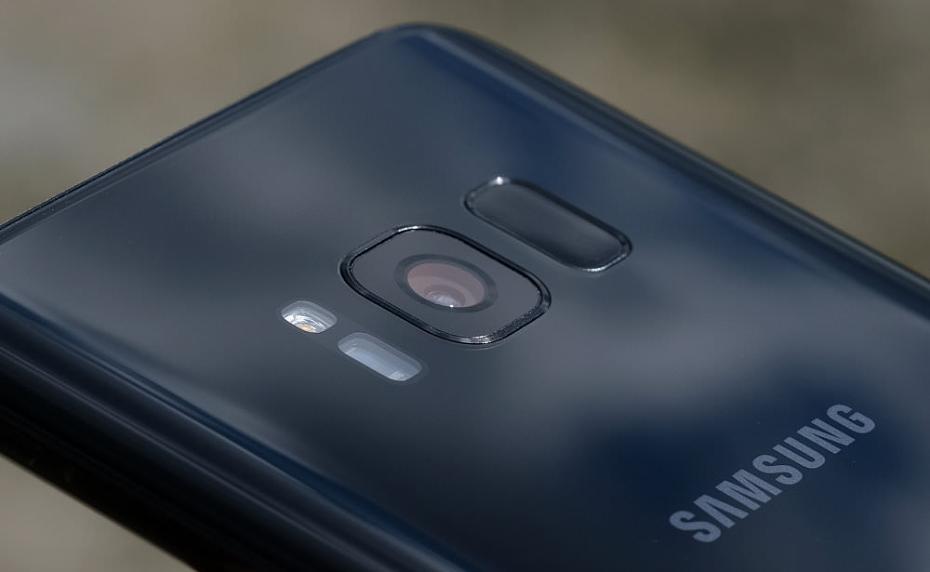
Samsung Galaxy S8 Camera
Unlike the upgrade from the S6 to the S7, the difference between the S7 and S8 is visible at first glance, with the screen dominating the phone, in a good way! You can see this, in this photo below, showing the HTC U Play (left), Samsung Galaxy S8 (middle), and Sony Xperia XZ (right). The Galaxy S8 is very similar in size to the other phones but features a 5.8inch screen compared to a 5.2-inch screen on the other phones (look at all that wasted space above and below the screen). The S8 is also narrower, making it easier to reach from one side of the screen to the other - although the height of the screen can make it a stretch at times from top to bottom.
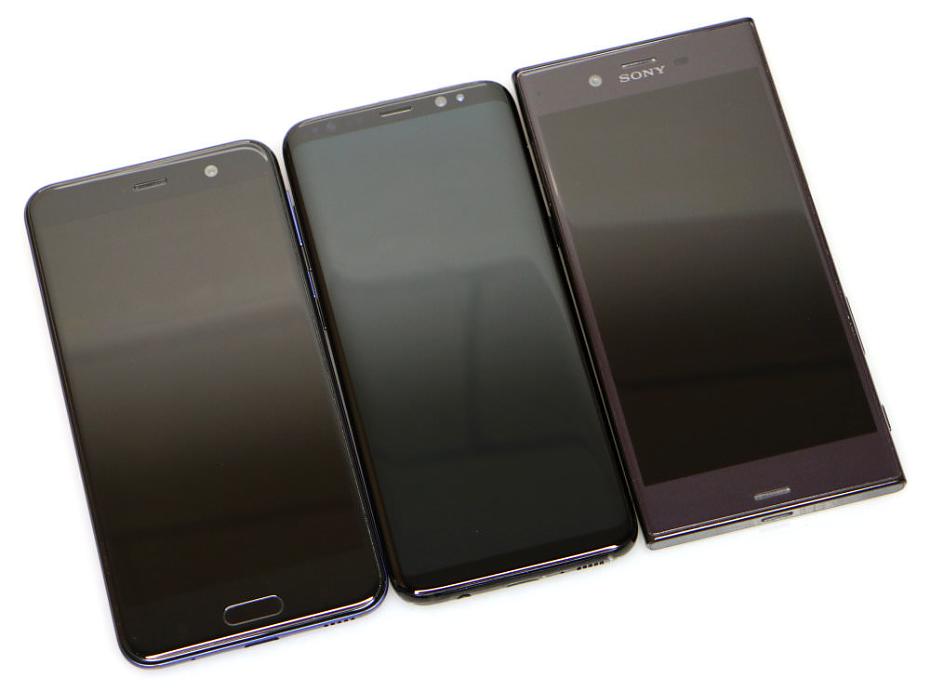
The Samsung Galaxy S8 looks rather nice, and photos don't particularly do it justice, as often it just looks like a flat black soap like object. However, the curved front and back of the smartphone, as well as the large screen with thin edges, makes the smartphone almost feel like all you're holding is a screen. One issue with the design of the S8 is the position of the fingerprint sensor, which is likely to cause you to put your finger over the camera lens, causing smudges, and lowering image quality. You can avoid this, however, by using one of the other methods for unlocking the phone.
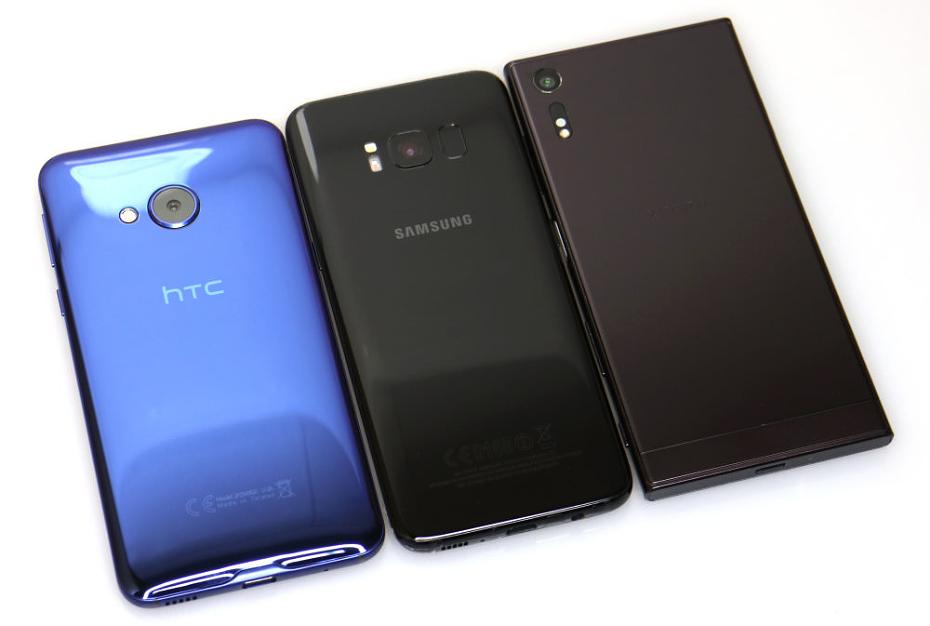
HTC U Play, Samsung Galaxy S8, Sony Xperia XZ rear.
The only smartphone out there that really gives it a run for its money in design and style is the HTC U (Play and Ultra), but only on the back. However, the design of the S8 is likely to look better in other colours, other than black. The design is also going to be spoilt (on all phones) once you put the now mandatory protective case on it, due to the glass rear. There's also the problem of trying to find a suitable case that will protect a curved screen, without blocking parts of the screen.
The Samsung Galaxy S8 performs extremely well, with the latest processor and plenty of memory. Like the S7, the camera focuses very quickly.
Geekbench v4.1.0 results are single core: 2011, multi-core score 6477, beating the HTC U Play (by a long way), and also beating the Xperia XZ quite noticeably (XZ scores 1656, and 3737). Thanks to the new SnapDragon 835 chip, with 8 cores, it also outperforms the Samsung Galaxy S7. The AnTuTu Benchmark (v6.2.7) score is 171384.
The screen is protected with Corning Gorilla Glass 5, which means it should survive being in a pocket with keys without scratching. The back is also protected by the same glass, but for anyone who's ever dropped a phone and seen the screen break, having a glass back could make you quite nervous, so a case is definitely recommended. The rear glass is also quite prone to fingerprints and smudges, so if you like your phone to stay clean this might soon become annoying.
Like the S7, there's no dedicated camera shutter release button on the S8, but the camera app opens up extremely quickly and responds almost instantly to presses of the on-screen shutter button. You can also use the volume control as a shutter release button.

There are a number of shooting modes available including Auto, Pro, Panorama, Selective Focus, Slow motion, Hyperlapse, Food, and Virtual shot. You can even download additional (free) shooting modes from Samsung, including Animated GIF, Beauty Face, Sports Shot, Dual Camera, and more. To view the modes available you simply slide your finger from the left to right. Sliding your finger from the right to left will bring up the effects available within the camera app. When using the selfie camera, there are a number of built-in effects available
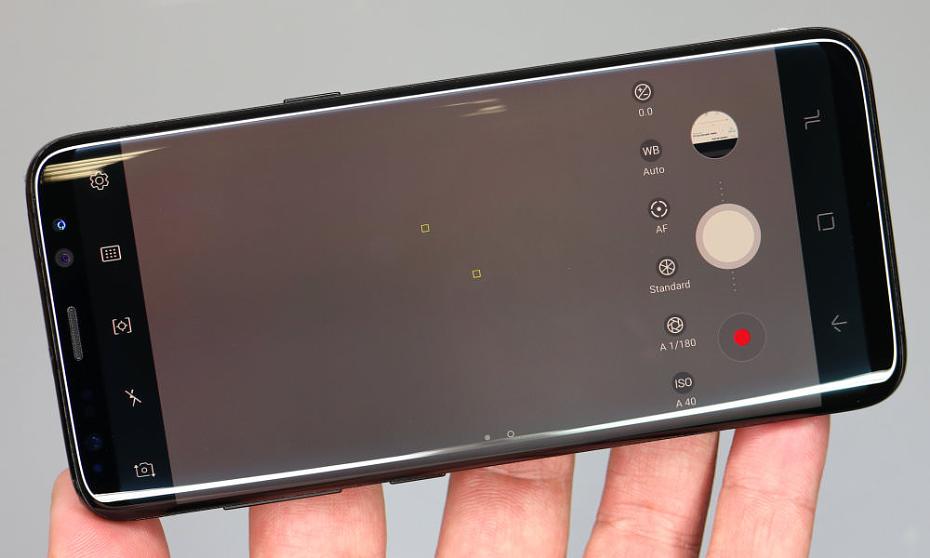
The camera app is easy to use and it's quick and easy to find options and change settings. The screen looks good whether used inside or outside, and it has an impressive resolution.
Bixby Vision requires the creation of a Samsung account and can help you find Wine, Text, Images or Shopping products similar to what you've pointed the camera at. The results are fairly disappointing, however, it's possible the translation feature may be useful for text.
Battery life - The Samsung Galaxy S8 has a 3000mAh battery, which is not removable. The phone should last at least a day, and the battery life appeared good even though the smartphone has an always on display that shows the time on screen. There are options to optimise battery life with different power saving modes.

Samsung Galaxy S8 Performance
The performance section is where we look at the image quality performance of the camera. Additional sample photos and product shots are available in the Equipment Database, where you can add your own review, photos and product ratings.
Samsung Galaxy S8 Sample Photos
Camera Performance - Colour is good, with the camera producing nice pleasing images straight from the camera. Exposure is reliable, and when left on auto settings, the camera will automatically switch to the HDR mode when needed to record more dynamic range in photos, without looking unnatural. The selfie (front) camera is improved, with an 8-megapixel sensor and AF, but can struggle with dynamic range at times, and using the HDR mode can help a little here.
Samsung Galaxy S8 Lens test images
Lens Performance - Detail is good, although images are softer in the far corners. With a f/1.7 aperture, the camera is capable of taking a photo that shows a blurred background, particularly when the subject is close to the lens. The camera can focus on subjects fairly close to the lens, giving reasonable macro focus.
Vignetting is not an issue, but there is some barrel distortion, and some pincushion distortion, although this can be fixed using the "Shape correction" option in the settings. For most shots, it was difficult to create flare in shots unless shooting directly into the sun, and the camera was impressively resistant to flare the rest of the time. If you shoot using the Pro mode, you can select raw shooting, and the camera will record Adobe DNG files, as well as JPEG images.
You can select "Selective Focus" and this will give you an image with a blurred background, but in playback you also get the option to choose the front focus, rear focus or pan focus (with everything in focus), these can then be saved as new images.
Samsung Galaxy S8 ISO test images
ISO Noise Performance - Noise is low from ISO50 to ISO200, with some appearing at ISO400. Above ISO400 and at ISO800 noise becomes more noticeable, and detail suffers. With a bright f/1.7 lens and optical image stabilisation, for most shots, you shouldn't need to use the higher ISO speeds. To get access to higher ISO speeds above ISO800, you will need to use a third-party app, such as Adobe Lightroom Mobile, and then ISO speeds up to ISO1600 become available.
Samsung Galaxy S8 White-balance test images
White Balance Performance - Auto White Balance (AWB) performs well under mixed light, as well as under Tungsten lighting, with a slightly warm result, and using the Tungsten preset gives a slightly cooler result. AWB also performs well under fluorescent lighting, with the fluorescent preset giving a slight magenta colour cast.
Samsung Galaxy S8 Digital filters
Digital Filters - There are 15 effects built-in to the camera app, and you can apply stickers or masks (on top of people's faces). You can also download additional effects, or use any number of third-party apps to edit images.
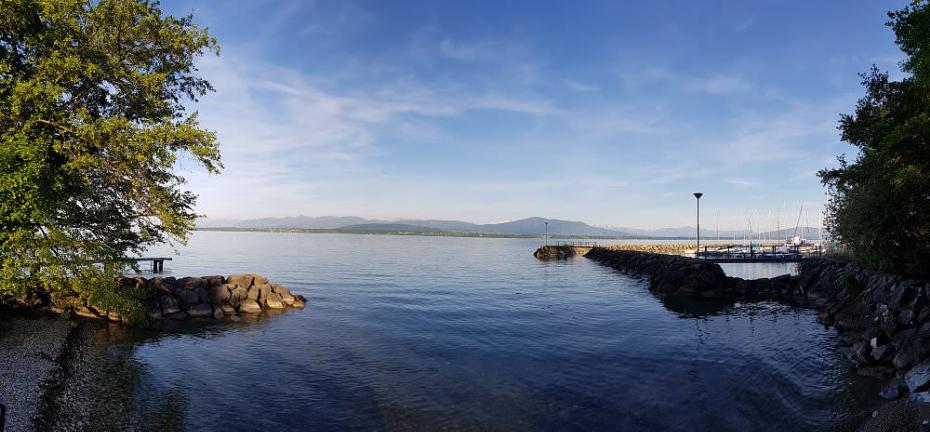
Samsung Galaxy S8 Panoramic - Lake Geneva | f/1.7 | 4.2 mm
Panorama mode - The camera has an automatic panoramic mode that automatically stitches the image as you pan from one side to another. The results are well stitched, and if you get the smoothness and speed right you get a very high-resolution image, with images we took between 30 and 53 megapixels.
Video - The camera records 4K (UHD), QHD, Full HD video with stereo sound, and optical image stabilisation is available in all modes. When recording in UHD, 1:1 or VGA resolution only optical image stabilisation is available, not both electronic and optical stabilisation. Results are very good, with good detail, and you can also take 9-megapixel images when recording 4K video. Image stabilisation works very well, although it can take a while for stabilisation to settle. You also have the option for continuous AF while recording. The camera performs quite well, even in low-light, thanks in part to the f/1.7 aperture lens. Additional videos can be found on the ePHOTOzine YouTube Channel.
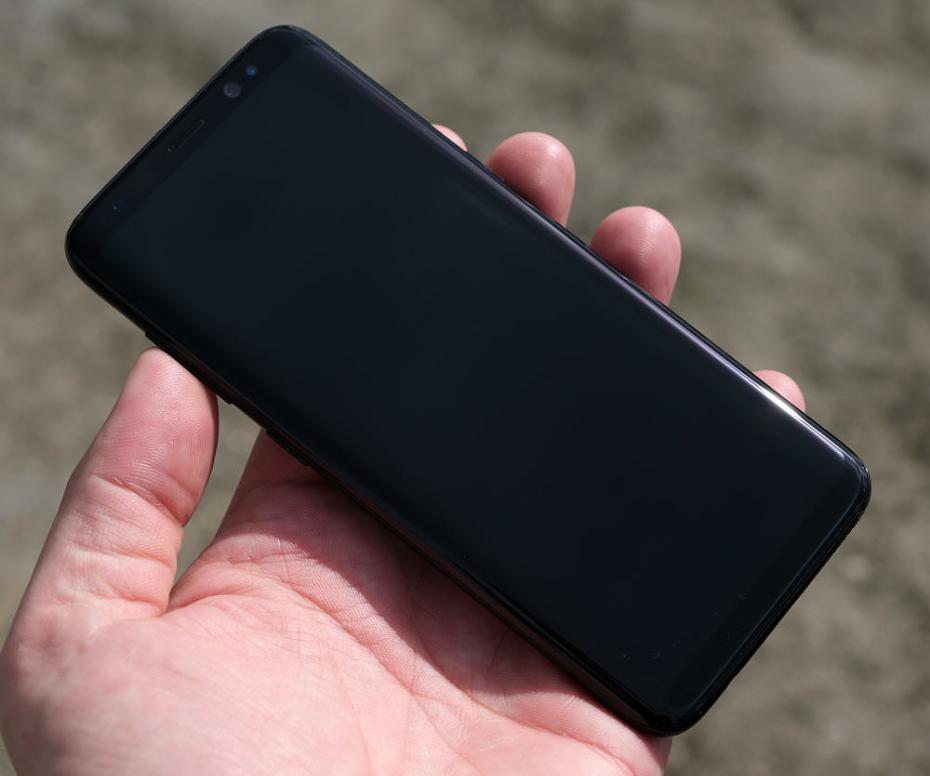
Value For Money
The Samsung Galaxy S8 is available for £635 sim-free, or £719 sim-free for the S8+ which makes it one of the most expensive phones available. Other premium smartphones include the Apple iPhone 7 Plus (£719 sim-free), LG G6 (£649 sim-free), HTC U Ultra (£649 sim-free), Google Pixel (£599 sim-free), Huawei P10 (£569 sim-free), and Sony Xperia XZ (£499 sim-free). If you want the same camera, but don't mind the previous design, then the Samsung Galaxy S7 is excellent value for money at £419 sim-free.
Here's a round-up of some of the alternatives to look at:
| Sensor | Lens | OIS | Screen | WP | GB | Price | |
| Kodak Ektra Smartphone | 21mp | f/2.0 | Y | 5.0 | N | 32 | £449 |
| Samsung Galaxy S8 | 12mp | f/1.7 | Y | 5.8 | Y | 64 | £635 |
| HTC U Ultra | 12mp | f/1.8 | Y | 5.7 | N | 64 | £495 |
| OnePlus 3 | 16mp | f/2.0 | Y | 5.5 | N | 64 | £330 |
| LG G6 | 13mp | f/1.8 + | Y | 5.7 | Y | 32 | £420 |
| Sony Xperia XZ | 23mp | f/2.0 | N * | 5.2 | Y | 32 | £399 |
| Sony Xperia X Compact | 23mp | f/2.0 | Y | 4.6 | N | 32 | £430 |
| Moto Z | 13mp | f/1.8 | Y | 5.5 | N** | 32 | £499 |
| iPhone 7 Plus | 12mp | f/1.8 ++ | Y ++ | 5.5 | Y | 32 | £719 |
| iPhone 7 | 12mp | f/1.8 | Y | 4.7 | Y | 32 | £599 |
| Google Pixel | 12mp | f/2.0 | N * | 5.0 | N | 32 | £599 |
+ LG G6 - has two rear cameras, a standard 13mp, and an ultra wide-angle 13mp camera.
++ iPhone 7 Plus - has two (rear) cameras, a wide-angle (28mm equivalent with OIS) and a telephoto (56mm equivalent without OIS) lens
* Google Pixel / Sony Xperia XZ features electronic image stabilisation, using a gyro sensor
** Moto Z features a "water repellent coating" but is not classed as waterproof
Have a look at more smartphones in our Top 10 Best Smartphones for Photographers. You'll also need to buy a MicroSD memory card and a case or bag to keep your smartphone safe and protected - have a look at our complete guide to camera bags, or have a look at the Best Samsung Galaxy S8 Cases.
Samsung Galaxy S8 Verdict
It seems strange that changing the screen ratio has made such a huge impact on the enjoyment of a smartphone, but a taller, narrower screen, means you've got plenty of space for apps, but you can also reach from one side to the other with one hand, and I'm able to reach the top and bottom of the phone with my thumb. The Samsung Galaxy S8 makes all other phones seem bulky with large frames, like when flatscreen TVs first came out and had huge frames.
The style is excellent, with a thin, and smooth body, with curved edges everywhere you look, even in the corners of the screen. All of this is quite quickly ruined by the addition of a case, needed to protect the phone. Unfortunately, ours is already scratched on the back, after only a few days ownership, and we'd recommend a Ringke Fusion S8 case as a good budget option. You could go for the official Samsung S8 case, which makes it easier to identify where the fingerprint sensor is. The curved screen is also more difficult to find protectors for, and when text ends up going into the far left and right of the screen the curved design can make it more difficult to read the text, so there are some drawbacks to the design. But drawbacks we're happy to live with.
The S8 has all of the benefits of the S7, including the same camera, waterproofing, MicroSD card slot, but with exceptional design improvements, increased memory and storage, as well as improved performance. The Samsung Galaxy S7 has one of the best cameras on a smartphone available, and the S8, with effectively the same camera, gives similarly excellent results, with one of the brightest lenses available at an impressive f/1.7. The camera is also capable of taking sharp, detailed images that look great, with colour that pops. With optical image stabilisation, ultra-fast phase-detection focus, and a 12-megapixel sensor, combined with a bright aperture, the S8 performs admirably in low-light.
The camera app gives excellent control, particularly in the Pro mode, where you can change manual settings, and shoot raw images. There are numerous shooting modes and effects, as well as the option to download additional features straight into the camera app. Add in the fact that you can use the camera underwater if the opportunity comes about, and you have an extremely capable camera, and smartphone, at your disposal.
If you want to shoot photos with your smartphone, and want one of the best possible cameras available, as well as a phone that impresses with a large 5.8inch screen, and a stylish design, then the Samsung Galaxy S8 is definitely at the cutting edge. For those that don't like the recent trend of smartphones growing in size, the Samsung Galaxy S8 offers an impressive screen size, whilst remaining compact thanks to the tall, but narrow display.
